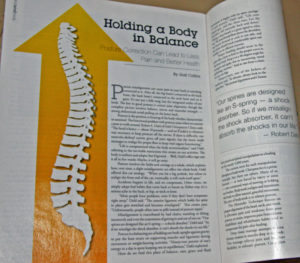![]() January 2011
January 2011
 Posture misalignment can cause pain in your back or anything connected to it. After all, the hip bone’s connected to the back bone, the back bone’s connected to the neck bone, and on it goes. It’s not just a folk song, but the integrated reality of our body. The key to good posture is correct joint alignment, though the complete picture involves balance, nerves and muscular strength—strong abdominals avoid pulling on the lower back.
Posture misalignment can cause pain in your back or anything connected to it. After all, the hip bone’s connected to the back bone, the back bone’s connected to the neck bone, and on it goes. It’s not just a folk song, but the integrated reality of our body. The key to good posture is correct joint alignment, though the complete picture involves balance, nerves and muscular strength—strong abdominals avoid pulling on the lower back.
 Posture is the position or bearing of the body whether characteristic or assumed. The functional problem with posture arises when we assume a pose to walk around. Robert E. Dahl of Dahl Chiropractic Clinics said, “The head is heavy—about 10 pounds—and we’ll hold it in whatever way necessary to keep pressure off the nerves. If there is difficulty, our musculo-skeletal system gives off pain signals, but the brain sends messages to realign for proper flow to keep vital organs functioning.”
Posture is the position or bearing of the body whether characteristic or assumed. The functional problem with posture arises when we assume a pose to walk around. Robert E. Dahl of Dahl Chiropractic Clinics said, “The head is heavy—about 10 pounds—and we’ll hold it in whatever way necessary to keep pressure off the nerves. If there is difficulty, our musculo-skeletal system gives off pain signals, but the brain sends messages to realign for proper flow to keep vital organs functioning.”
“Life is compromised when the body accommodates,” said Dahl, referring to the inevitable restrictions this creates in our activities. The body is resilient and adapts, but if ignored… Well, Dahl’s office sign says it all in five words: Maybe, it will go away.
Posture involves the limbs and carriage as a whole, which explains how, over time, a slight misalignment can affect the whole body. Dahl offered this car analogy. “When you hit a big pothole, but refuse to realign the front end of the car, eventually, it will rattle itself apart.”
Accidents happen in a life, and we compensate. Other times, we simply adopt bad habits that come back to haunt us. Either way, it’s a serious ache in the back, or hip, or neck or knee.
“Most people have problems, even if they don’t have symptoms right away,” said Dahl. “The anterior ligament which holds the spine in place gets stretched and becomes misaligned.” This creates pain. “Unfortunately, people often turn to pills instead of posture repair.”
Misalignment is exacerbated by bad chairs, standing or lifting incorrectly and even the contortions of getting in and out of our car. “Our spines are designed like an S-spring—a shock absorber,” said Dahl. “So if we misalign the shock absorber, it can’t absorb the shocks in our life.”
Posture is a balancing act of holding our body upright against gravity to put the least strain on supporting muscles and ligaments during movement or weight-bearing activities. “Ninety-two percent of one’s energy in a day is spent keeping one in equilibrium,” Dahl explained.
How do we find this place of balance, ease, grace and fluid movement? It begins with an open carriage. “I teach posture,” Dahl said. “Lift your diaphragm, and the chest rises. Let the shoulders fall naturally back and down.” Taking a deep breath is a great signal to relax, too. The head should float above the shoulders, not hunch forward or cock to one side, and our joints should stack comfortably upon one another in an efficient manner.
“Proper bending should occur in the pelvis like a bow to lock in the proper curve in the lower back. Keep it at a 30-degree angle for strength and apply this to vacuuming, wood gathering, etcetera.” And to rise from a chair, we use our legs.
Hippocrates, one of the fathers of medicine, said “In disease, always look to the spine first.” The ancient Egyptians and Chinese have practiced spinal manipulation as a healing art for nearly 5000 years.
The current term for such manipulation therapies is bodywork. Chiropractics is a prime example, but there are others. Many of us learned—or were forced by injury or stress— into unnatural ways of moving or holding our bodies. Bodywork realigns and repositions the body to allow natural, graceful movement. The aim of bodywork is to relearn posture.
The Alexander Technique focuses on proper alignment of the head, neck and trunk. It alleviates pain and weakness from poor posture or strain, improves pain from chronic disabilities and rehabilitates habits used to compensate for pain after healing.
Deep tissue massage attempts to treat chronic tension in muscles deep in the body. This massage relieves pain and increases flexibility to enhance posture. Congestion is cleared to reduce edema, inflammation and pain while softening fibrous muscle that restricts joints causing structural misalignment.
Yoga and Pilates stretch muscles and strengthen the core, improving posture. Their primary purposes are to correct misalignments in the physical and energetic body. This prevents injury while lending grace and fluidity of movement.
For perfect posture, combine relaxation, flexibility, core strengthening exercises and positive ergonomics. And if you slip on the ice, get checked out because it might not go away. NAMLM Gail G. Collins
